High Thermal Conductivity of Flake Graphite Reinforced Polyethylene Composites Fabricated by the Powder Mixing Method and the Melt-Extruding Process
Abstract
1. Introduction
2. Experimental Methods
2.1. Materials and Morphology
2.2. Experiment and Measurement
3. Results and Discussion
3.1. Influence of the Weight Content of one Size of FG on the Thermal Conductivity of HDPE/FG
3.2. Thermal Conductivities of HDPE with 5 wt % Fillers
3.3. Influence of Hybrid Filling Mode on the Thermal Conductivities of HDPE with 40 wt % Fillers
3.4. Morphology of Composites
3.5. Thermal Stability Analysis about FG/HDPE Composites
3.6. Material Strength Analysis about FG/HDPE Composites
4. Conclusions
Author Contributions
Funding
Conflicts of Interest
References
- Li, J.; Vaisman, L.; Marom, G.; Kim, J. Br treated graphite nanoplatelets for improved electrical conductivity of polymer composites. Carbon 2007, 45, 744–750. [Google Scholar] [CrossRef]
- Kim, H.; Kobayashi, S.; AbdurRahim, M.A.; Zhang, M.J.; Khusainova, A.; Hillmyer, M.C.; Abdala, A.A.; Macosko, C.W. Graphene/polyethylene nanocomposites: Effects of polyethylene functionalization and blending methods. Polymer 2011, 52, 1837–1846. [Google Scholar] [CrossRef]
- Cao, B.; Li, Y.; Kong, J.; Chen, H.; Xu, Y.; Yung, K.L.; Cai, A. High thermal conductivity of polyethylene nanowire arrays fabricated by an improved nanoporous template wetting technique. Polymer 2011, 52, 1711–1715. [Google Scholar] [CrossRef]
- Shen, S.; Henry, A.; Tong, J.; Zheng, R.; Chen, G. Polyethylene nanofibres with very high thermal conductivities. Nat. Nanotechnol. 2010, 5, 251–255. [Google Scholar] [CrossRef] [PubMed]
- Kim, G.; Lee, D.; Shanker, A.; Shao, L.; Kwon, M.S. High thermal condutivity in amorphous polymer blends by engineered interchain interactions. Nat. Mater. 2014, 14, 295–300. [Google Scholar] [CrossRef] [PubMed]
- Henry, A.; Chen, G. High thermal conductivity of single polyethylene chains using molecular dynamics simulations. Phys. Rev. Lett. 2008, 101, 235502. [Google Scholar] [CrossRef] [PubMed]
- Liao, Q.; Liu, Z.; Liu, W. Extremely high thermal conductivity of aligned carbon nanotube-polyethylene composites. Sci. Rep. 2015, 5, 16543. [Google Scholar] [CrossRef] [PubMed]
- Tu, R.; Liao, Q.; Zeng, L.; Liu, W.; Liu, Z. Impact of torsion and stretching on the thermal conductivity of polyethylene strands. Appl. Phys. Lett. 2017, 110, 101905. [Google Scholar] [CrossRef]
- Liao, Q.; Zeng, L.; Liu, Z.; Liu, W. Tailoring thermal conductivity of single-stranded carbon-chain polymers through atomic mass modification. Sci. Rep. 2016, 6, 34999. [Google Scholar] [CrossRef] [PubMed]
- Zhang, T.; Wu, X.; Luo, T. Polymer nanofibers with outstanding thermal conductivity and thermal stability: Fundamental linkage between molecular characteristics and macroscopic thermal properties. J. Phys. Chem. C 2014, 118, 21148–21159. [Google Scholar] [CrossRef]
- Luo, T.; Lloyd, J.R. Enhancement of thermal energy transport across graphene/graphite and polymer interfaces: A molecular dynamics study. Adv. Funct. Mater. 2012, 22, 2495–2502. [Google Scholar] [CrossRef]
- Teng, C.C.; Ma, C.C.M.; Lu, C.H.; Yang, S.Y.; Lee, S.H. Thermal conductivity of non-covalent functionalized graphene/epoxy composites. Carbon 2011, 49, 5107–5116. [Google Scholar] [CrossRef]
- Kim, H.S.; Kim, J.H.; Yang, C.; Kim, S.Y. Synergistic enhancement of thermal conductivity in composites filled with expanded graphite and multi-walled carbon nanotube fillers via melt-coupling based on polymerizable low-viscosity oligomer matrix. J. Alloys Compd. 2017, 690, 274–280. [Google Scholar] [CrossRef]
- Lin, J.; Zhang, H.; Tang, M.; Tu, W.; Zhang, X. Improved thermal property of a multilayered graphite nanoplatelets filled silicone composites. J. Mater. Eng. Perform. 2015, 24, 920–929. [Google Scholar] [CrossRef]
- Ye, C.; Shentu, B.; Weng, Z. Thermal conductivity of high density polyethylene filled with graphite. J. Appl. Polym. Sci. 2006, 101, 3806–3810. [Google Scholar] [CrossRef]
- Yu, W.; Zhao, J.; Wang, M.; Hu, Y.; Chen, L.; Xie, H. Thermal conductivity enhancement in thermal grease containing different CuO structure. Nanoscale Res. Lett. 2015, 10, 113. [Google Scholar] [CrossRef] [PubMed]
- Zhou, W.; Qi, S.; An, Q.; Zhao, H.; Liu, N. Thermal conducticity of boron nitride reinforced polyethylene composites. Mater. Res. Bull. 2007, 42, 1863–1873. [Google Scholar] [CrossRef]
- Mamunya, Y.P.; Davydenko, V.V.; Pissis, P.; Lebedev, E.V. Electrical and thermal conductivity of polymers filled with metal powders. Eur. Polym. J. 2011, 38, 1887–1897. [Google Scholar] [CrossRef]
- Xiao, M.; Sun, L.; Liu, J.; Li, Y.; Gong, K. Sythesis and properties of polystyrene/graphite nanocomposites. Polymer 2002, 43, 2245–2248. [Google Scholar] [CrossRef]
- Cai, L.; Song, A.Y.; Wu, P.; Hsu, P.; Peng, Y.; Chen, Y.; Liu, C.; Catrysse, P.B.; Liu, Y.; Yang, A.; et al. Warming up human body by nanoporous metallized polyethylene textile. Nat. Commun. 2017, 8, 496. [Google Scholar] [CrossRef] [PubMed]
- Zhai, Y.; Ma, Y.; David, S.N.; Zhao, D.; Lou, R.; Tan, G.; Yang, R.; Yin, X. Scalable-manufactured randomized glass-polymer hybrid metamaterial for daytime radiative cooling. Science 2017, 355, 1062–1066. [Google Scholar] [CrossRef] [PubMed]
- Zhou, S.; Zhu, Y.; Du, H.; Li, B.; Kang, F. Preparation of oriented graphite/polymer composite sheets with high thermal conductivity by tape casting. New Carbon Mater. 2012, 27, 241–249. [Google Scholar] [CrossRef]
- Wang, W.; Yang, X.; Fang, Y.; Ding, J.; Yan, J. Preparation and thermal properties of polyethylene glycol/expanded graphite blends for energy storage. Appl. Energy 2009, 86, 1479–1483. [Google Scholar] [CrossRef]
- Zhou, S.; Chen, Y.; Zou, H.; Liang, M. Thermally conductive composites obtained by flake graphite filling immiscible polyamide 6/polycarbonate blends. Thermochim. Acta 2013, 566, 84–91. [Google Scholar] [CrossRef]
- Zhou, W.; Wang, C.; An, Q.; Ou, H. Thermal properties of heat conductive silicone rubber filled with hybrid fillers. J. Compos. Mater. 2008, 42, 173–187. [Google Scholar] [CrossRef]
- Bejan, A. Constructal-theory network of conducting paths for cooling a heat generating volume. Int. J. Heat Mass Transf. 1997, 40, 799–816. [Google Scholar] [CrossRef]
- Chen, H.; Ginzburg, V.V.; Yang, J.; Yang, Y.; Liu, W.; Huang, Y.; Du, L.; Chen, B. Thermal conductivity of polymer-based composites: Fundamentals and applications. Prog. Polym. Sci. 2016, 59, 41–85. [Google Scholar] [CrossRef]
- He, H.; Fu, R.; Han, Y.; Shen, Y.; Wang, D. High thermal conductive Si3N4 particle filled epoxy composites with a novel structure. J. Electron. Packag. 2007, 129, 469–472. [Google Scholar] [CrossRef]
- Agari, Y.; Ueda, A.; Nagai, S. Thermal-conductivities of composites in several types of dispersion-systems. J. Appl. Polym. Sci. 1991, 42, 1665–1669. [Google Scholar] [CrossRef]
- Lin, J.; Zhang, H.; Hong, H.; Liu, H.; Zhang, X. A thermally conductive composite with a silica gel matrix and carbon-encapsulated copper nanoparticles as filler. J. Electron. Mater. 2014, 43, 2759–2769. [Google Scholar] [CrossRef]
- Tsutsumi, N.; Takeuchi, N.; Kiyotsukuri, T. Measurement of thermal diffusivity of filler-polyimide composites by flash radiometry. J. Polym. Sci. Part B 1991, 29, 1085–1093. [Google Scholar] [CrossRef]
- Wu, H.; Lawrence, T.D. High thermally conductive graphite nanoplatelet/polyetherimide composite by precoating: Effect of percolation and particle size. Polym. Compos. 2013, 34, 2148–2153. [Google Scholar] [CrossRef]
- Feng, T.; Ruan, X.; Ye, Z.; Cao, B. Spectral phonon mean free path and thermal conductivity accumulation in defected graphene: The effects of defect type and concentration. Phys. Rev. B 2015, 91, 224301. [Google Scholar] [CrossRef]
- Huang, X.; Iizuka, T.; Jiang, P.; Ohki, Y.; Tanaka, T. Role of interface on the thermal conductivity of highly filled dielectric epoxy/AlN composites. J. Phys. Chem. C 2012, 116, 13629–13639. [Google Scholar] [CrossRef]
- Yao, Y.; Zeng, X.; Pan, G.; Sun, J.; Hu, J.; Huang, Y.; Sun, R.; Hu, J.-B.; Wong, C.-P. Interfacial engineering of silicon carbide nanowire/cellulose microcrystal paper toward high thermal conductivity. ACS Appl. Mater. Interface 2016, 8, 31248–31255. [Google Scholar] [CrossRef] [PubMed]
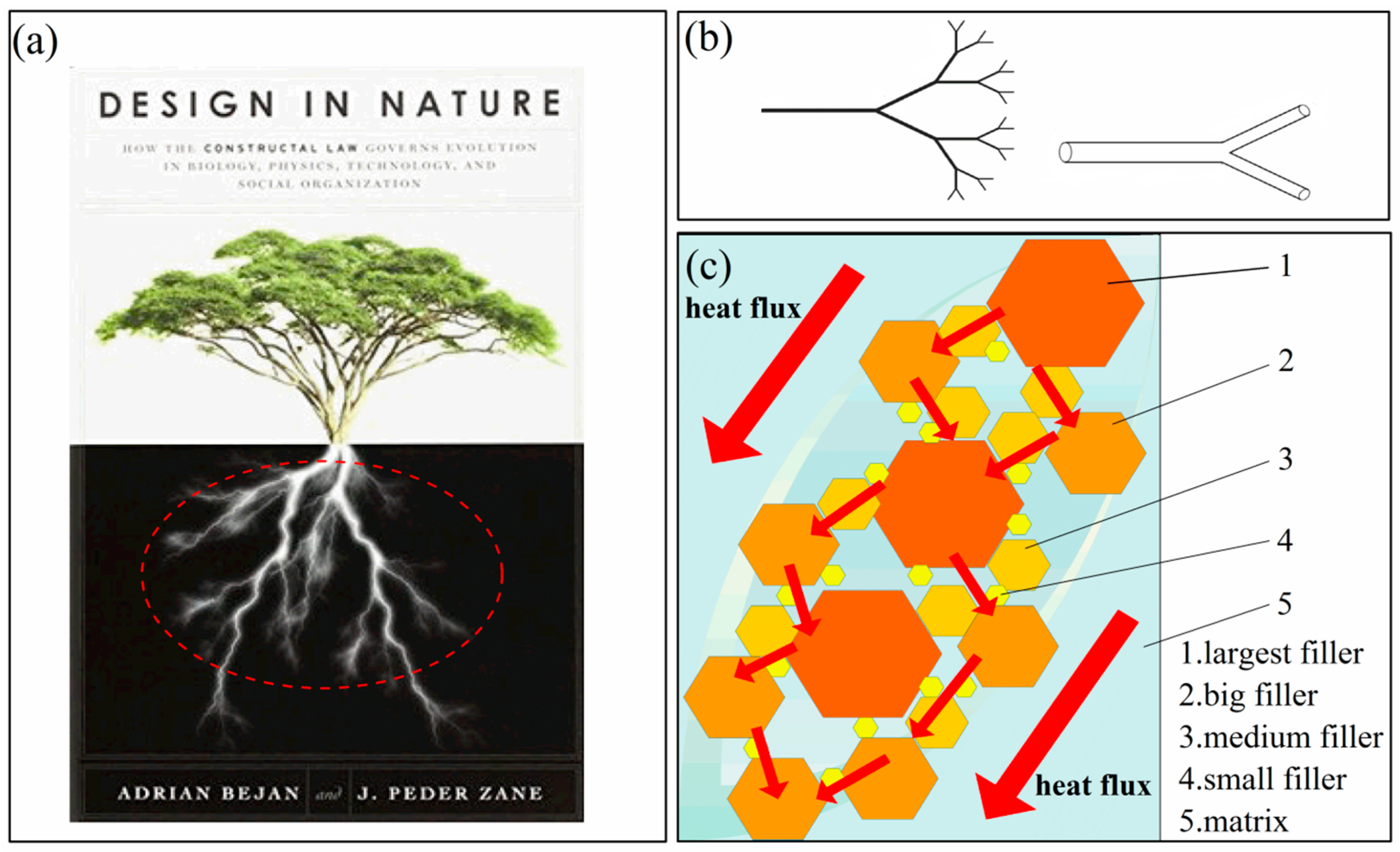
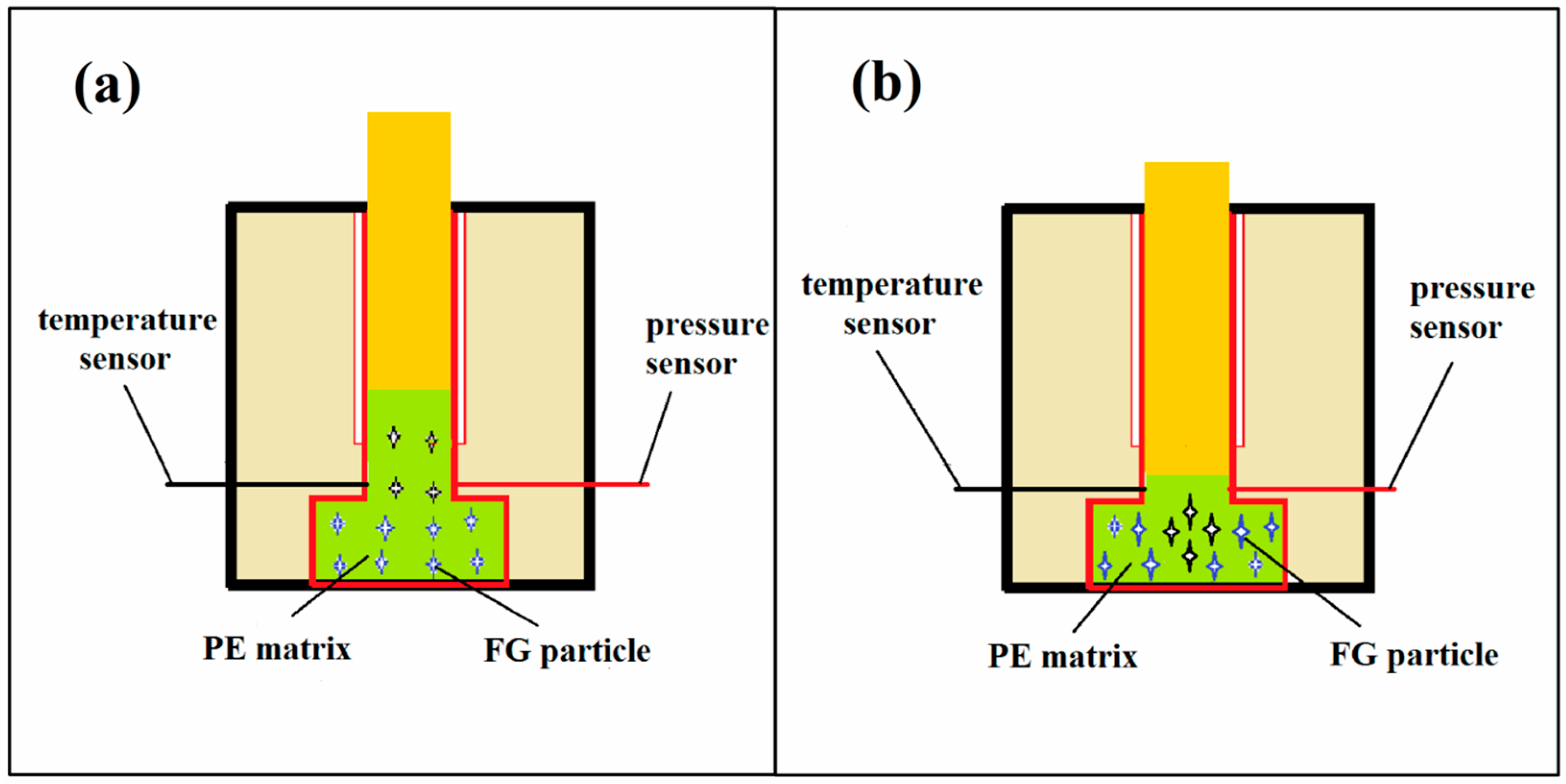
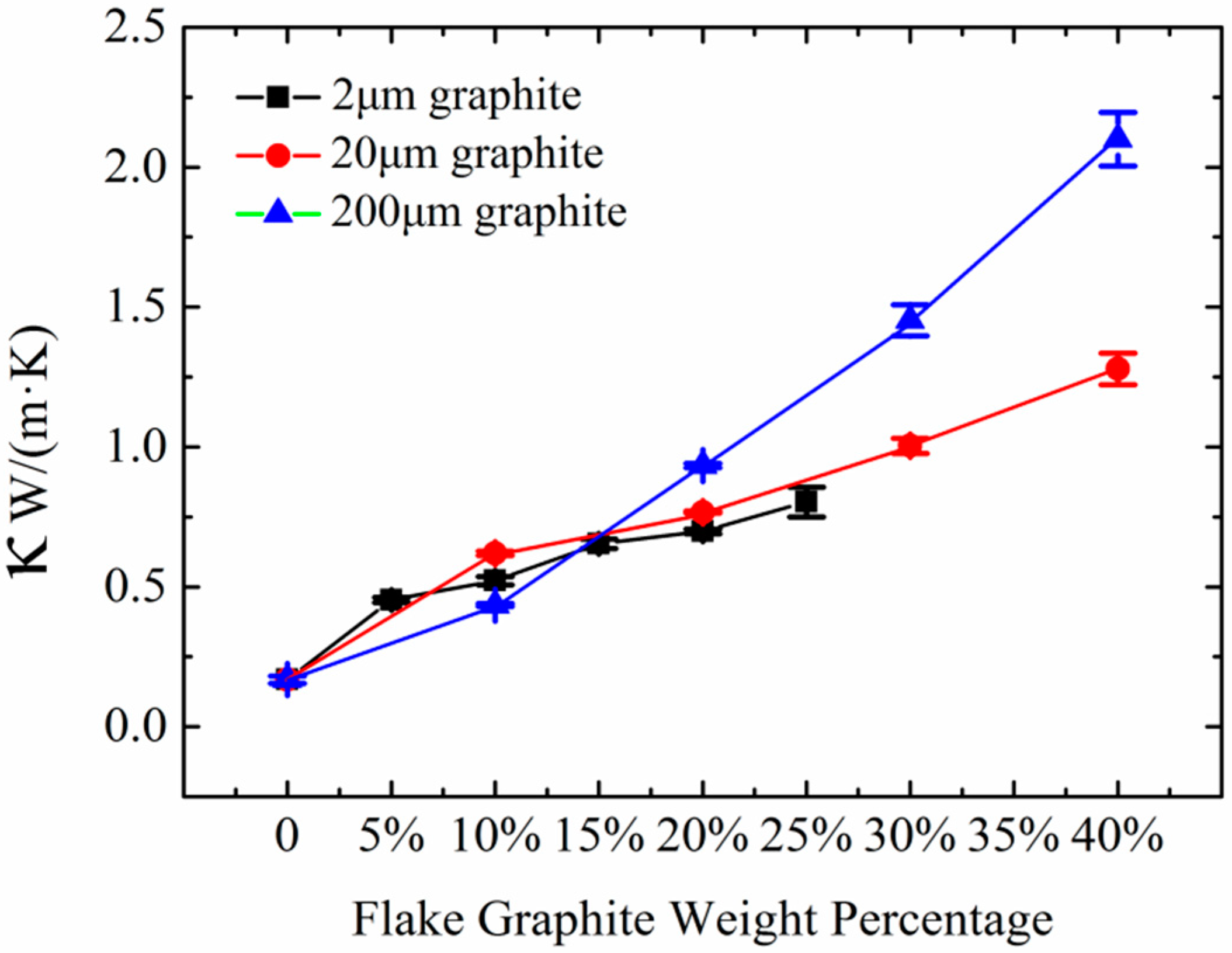
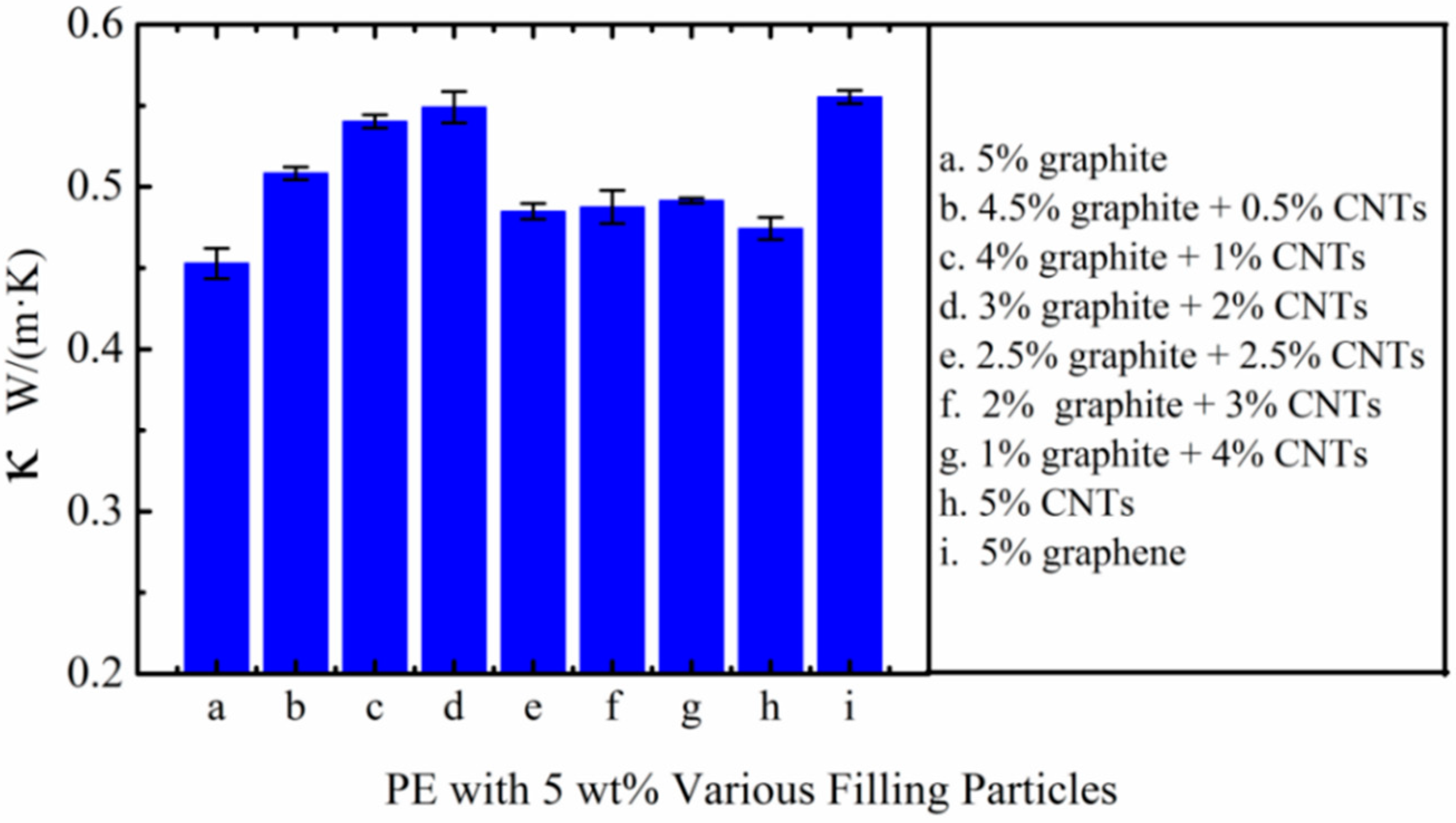
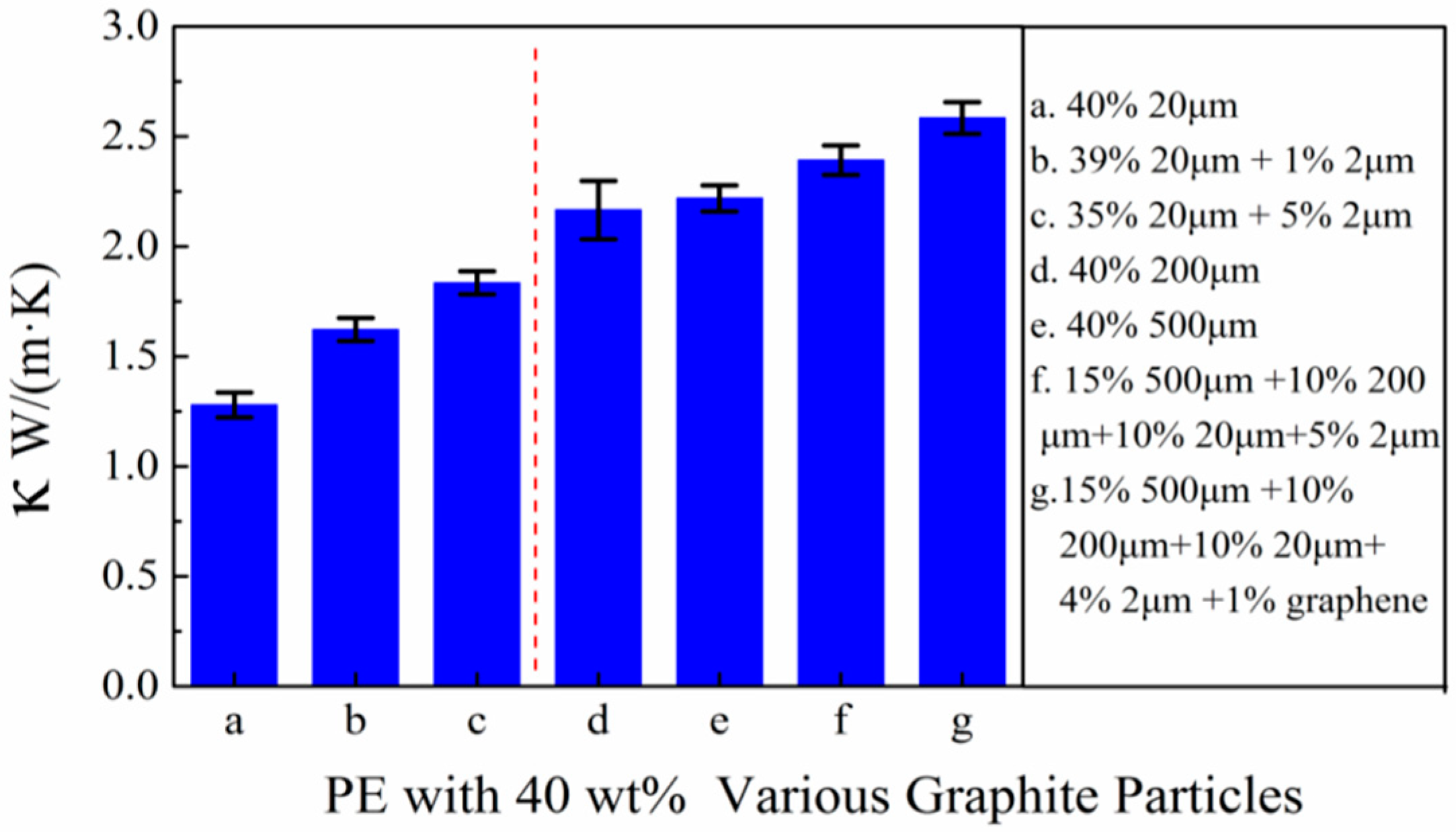
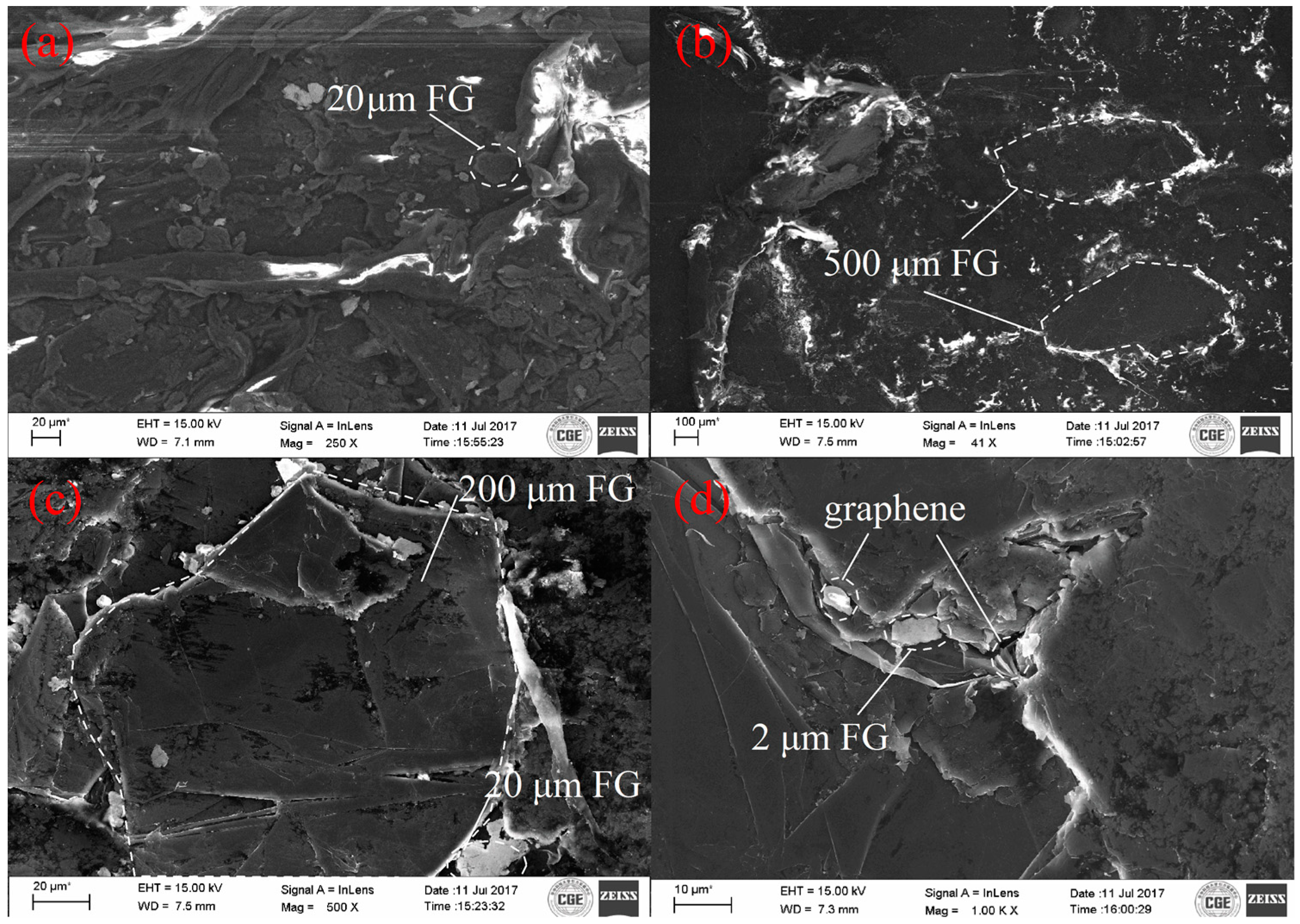
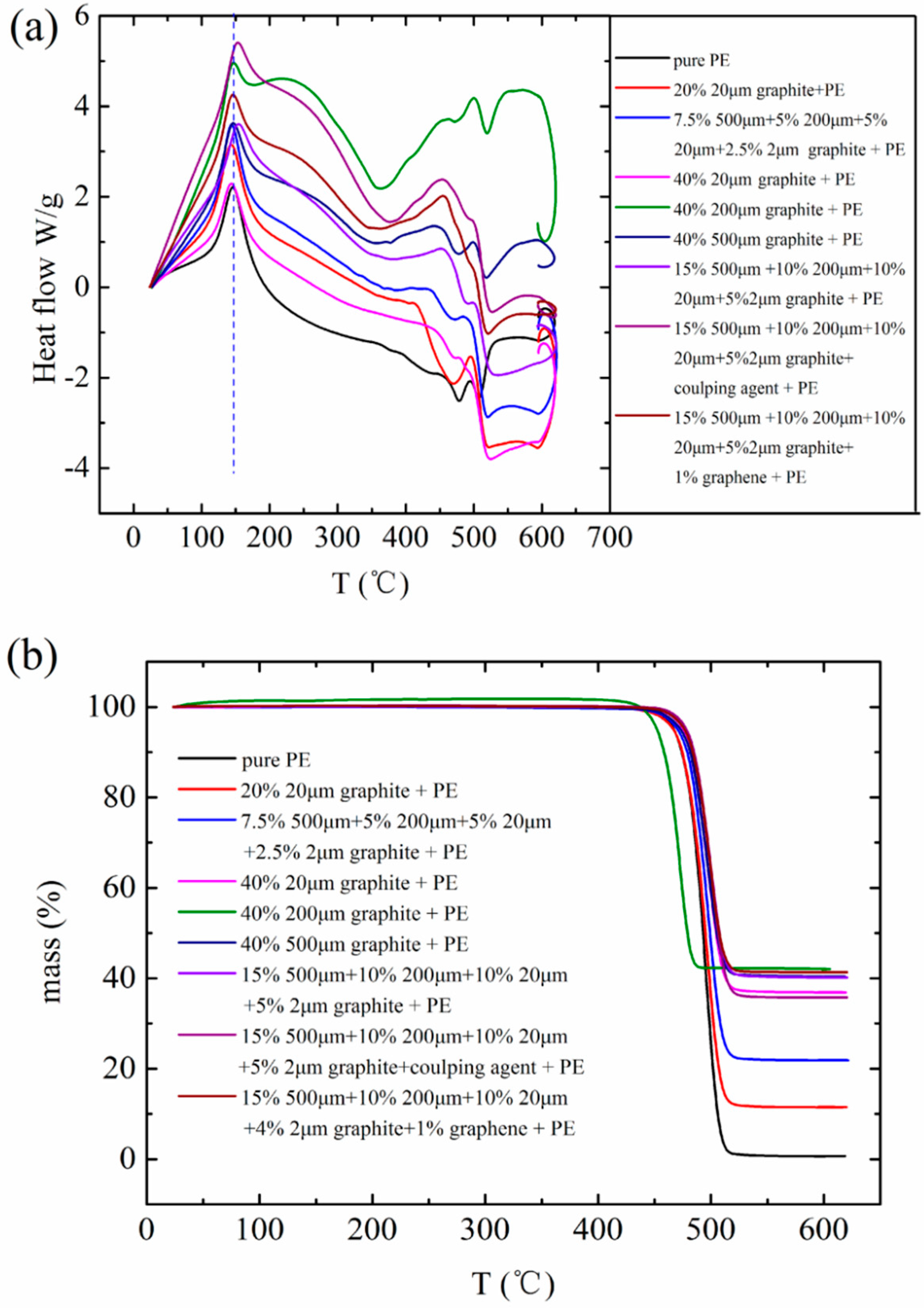
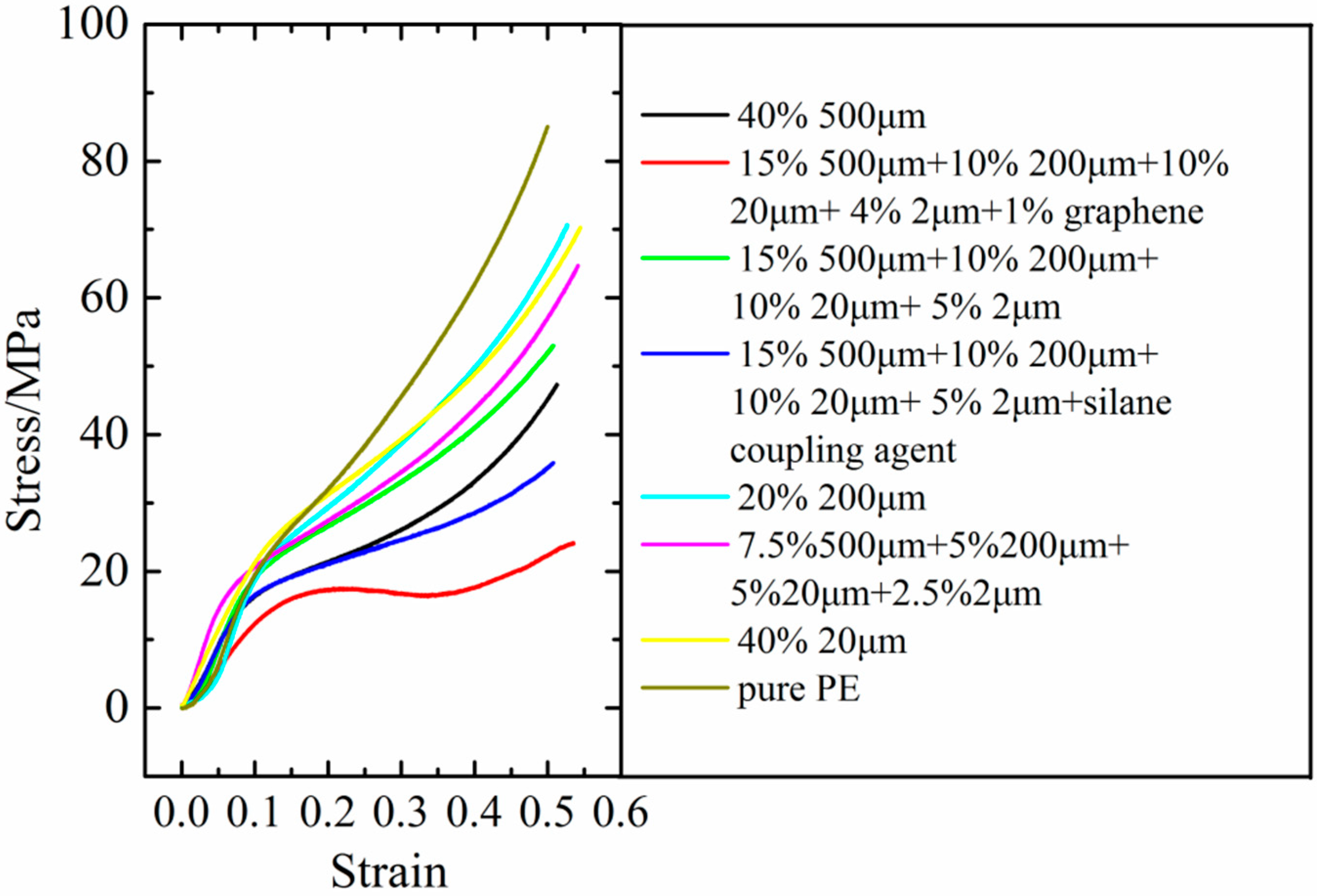
| Species | HDPE | FG 1 | FG 2 | FG 3 | FG 4 | Graphene | MWCNTs |
|---|---|---|---|---|---|---|---|
| Factory size/μm | 250 | 2 | 20 | 200 | 500 | 5–10 | 10–20 |
| Test size/μm | 211.27 | 3.27 | 19.99 | 224.05 | 680.19 | 5.51 | 14.32 |
© 2018 by the authors. Licensee MDPI, Basel, Switzerland. This article is an open access article distributed under the terms and conditions of the Creative Commons Attribution (CC BY) license (http://creativecommons.org/licenses/by/4.0/).
Share and Cite
Liu, Z.; Tu, R.; Liao, Q.; Hu, H.; Yang, J.; He, Y.; Bian, H.; Ma, L.; Liu, W. High Thermal Conductivity of Flake Graphite Reinforced Polyethylene Composites Fabricated by the Powder Mixing Method and the Melt-Extruding Process. Polymers 2018, 10, 693. https://doi.org/10.3390/polym10070693
Liu Z, Tu R, Liao Q, Hu H, Yang J, He Y, Bian H, Ma L, Liu W. High Thermal Conductivity of Flake Graphite Reinforced Polyethylene Composites Fabricated by the Powder Mixing Method and the Melt-Extruding Process. Polymers. 2018; 10(7):693. https://doi.org/10.3390/polym10070693
Chicago/Turabian StyleLiu, Zhichun, Runchun Tu, Quanwen Liao, Hanlin Hu, Jinguo Yang, Yan He, Huiguang Bian, Lianxiang Ma, and Wei Liu. 2018. "High Thermal Conductivity of Flake Graphite Reinforced Polyethylene Composites Fabricated by the Powder Mixing Method and the Melt-Extruding Process" Polymers 10, no. 7: 693. https://doi.org/10.3390/polym10070693
APA StyleLiu, Z., Tu, R., Liao, Q., Hu, H., Yang, J., He, Y., Bian, H., Ma, L., & Liu, W. (2018). High Thermal Conductivity of Flake Graphite Reinforced Polyethylene Composites Fabricated by the Powder Mixing Method and the Melt-Extruding Process. Polymers, 10(7), 693. https://doi.org/10.3390/polym10070693






